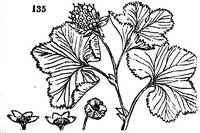443. In horticulture the Swedes are considered successful operators; but their short summers are adverse to the culture of many sorts of fruits and culinary vegetables in the open air; and there is not yet sufficient wealth to admit of much forcing, or of forming artificial climates to any extent. The apple, pear, and plum ripen their fruits in the best districts, especially in warm situations; but where the better varieties are grown, they are always planted against walls, and protected, as in Denmark. The Rubus Chamï¾µmorus, or cloudberry (fig. 135.), is very common in Lapland: its fruit is deli-cious, and is sent in immense quantities, in autumn, from all the north of the Gulf of Bothnia, to Stockholm, where it is used for sauces, in soups, and in making vinegar Dr. Clarke says he was cured of a bilious fever chiefly from eating this fruit. The fruits generally cultivated in Sweden are the following: Apples: Rosenhï¾µger, Astrachan, red winter, Engl. Gylden, Calville rouge, Danziger Kantapple, White Gylden, Passe-pomme rouge, Union, Pincess Noble, Pomme de Jerusalem, Pepin d'or (golden pippin), Borstorffer, Pigeon. Pears: Winter bonchretien, Summer bonchretien, Jaragonelle, Double bergamot, Summer bergamot, Margarette, Fig, Windsor, Beurre blanc, Beurre gris, Sugar, Iron, Dry, Cinnamon. Plums: Blue Swedsker, Green Swedsker, Reine Claude (Green gage), Yellow egg, Red egg, Green mirabelle, Yellow mirabelle, King, Damascene. Cherries: Yellow bigarreau, White bigarreau, May duke, Black Spanish, Double sweet morello, King cherry, Pound cherry, Kirsch van der Nacht (for preserving), Apricots: Early Hungarian, Large Breda, Small early Orange. Peach: Double montagne. Nectarine: Brugnon, or Violet hatif. Grapes: Wassersiet, White Muscadine, or early Margaret. Sweetwater, Blue Leipzig, or blue cluster, and blue August grape. These sorts of grapes are most commonly cultivated in gentlemen's gardens; but Professsor Sonneberg of Lund, a great amateur, has in his collection ten different sorts, grown and described by M. Lindegaard of Rosenborg. Walnuts: 1. Double, 2. Single, 3. Tender-shelled, 4. Thick-shelled, Raspberries, Gooseberries, Cur. rants, and Strawberries. The culinary vegetables grown by the farmers and cottagers in Scione, are blue or brown borecole, Rosen cabbage, a very delicate green cabbage or kale, white cabbage, onions, carrots, parsley, parsneps, red beet, potatoes, kohl-rabi, and rutabaga: sea-kale has been tried by way of experiment. Autumn or harvest turnips, a variety generally sown about midsummer on heathy wastes which have been pared and burned, leek, marjoram, thyme, sorrel. The brown kidneybean is in some places grown in great quantities; and, when ripe, it is stewed with sugar and vinegar, and is usually termed 'sour and sweet.' The white runner is rare, as is also the sugar pea. Caraway and anise are grown for seasoning rye bread. Astragalus bï¾µ'ticus is grown by almost every farmer, for the purpose of mixing with coffee. Tobacco, as we have already observed, is a good deal cultivated in Sweden; and, after carefully trying eleven sorts, M. Gernandt, the late curator of the botanic garden at Lund, gave the preference to the Maryland (Nicotiana fruticosa crispula Agardh), and the Brazilian (N. decurrens Agardh); that commonly grown is the N. rustica. The grower generally sells the tobacco to the manufacturer, after it is dried under cover, but not fermented.

